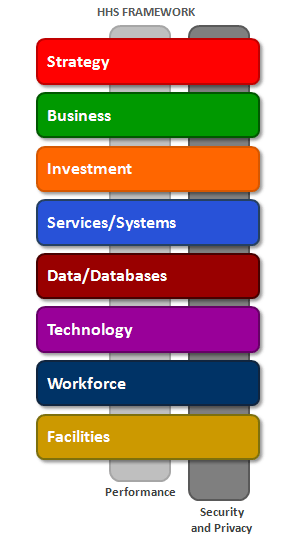The HHS Enterprise ArchitectureThe HHS Enterprise Architecture (EA) provides a mechanism for understanding and managing complexity and change as it pertains to key HHS-wide business processes and their related IT support. The HHS EA aligns with the Federal Enterprise Architecture (FEA) and is a strategic resource that helps HHS plan and implement information technology solutions and manage the resulting investment portfolio to meet mission and business needs. The HHS EA can guide IT investments and ensure alignment of the IT investment with HHS plans at both the strategic and detail levels. The HHS EA is also a core decision support tool that integrates enterprise information, planning, and management functions (including aspects of strategic planning, human capital, continuity of operations, security, investment, business processes redesign, information management, and facilities). The diagram below depicts the layers of the HHS architecture. Each layer of the architecture contains information specific to that category, and is related to other information across the architecture. The HHS EA aligns with the FEA and links to information about the FEA are provided below.  | Strategy – identify the strategic goals and objectives for COOP and/or Pandemic | | Business – determine what essential business activities are needed to achieve the goals and objectives and how they will be continued. | | Investment – represents the financial aspect of an enterprise. It includes concepts that allow the EA information to be reconciled with investment and project control information. | | Data – determine what data will be needed to support the business activities, and where it can be obtained. | | Services/Systems – identify any needed systems that will provide the services needed to support the above business activities and how they will be made available | | Technology – identify the technology to be used in building the system services | | Workforce – identify the roles and key positions needed to support the above business activities | | Facilities – identify the facilities needed to support the business activities above. | | Security and Privacy – identify the security controls that are to be in place at each layer and how they will be implemented | | Performance – identify measurement indicators to measure performance at all levels of the enterprise |
HHS EA Principles The HHS Enterprise Architecture functions based on the following 9 principles. HHS EA PRINCIPLES |
|---|
HHS EA PRINCIPLE 1 HHS is citizen-centered and business-driven, with services defined and delivered based on the needs of their consumers. (Customer Focused) | HHS EA PRINCIPLE 2 HHS is performance-driven, measuring success in terms of mission execution and continuous improvement towards meeting HHS Strategic Goals and Objectives. (Performance) | HHS EA PRINCIPLE 3 The HHS EA reflects a standards-based approach that promotes and facilitates technology standardization and reuse, interoperability, data sharing, and overall Departmental efficiency and effectiveness. (Standards) | HHS EA PRINCIPLE 4 HHS develops and implements business services using a required, structured Enterprise Performance Life Cycle methodology. (EPLC) | HHS EA PRINCIPLE 5 HHS manages information and data as enterprise assets, ensuring integrity, confidentiality, and availability, at all levels of the department. (Information Assets) | HHS EA PRINCIPLE 6 HHS requires security and privacy practices to protect information assets from unauthorized use, disclosure, disruption, modification, or destruction. (Security/Privacy) | HHS EA PRINCIPLE 7 HHS integrates the planning, management, and governance of all HHS OPDIV enterprise architectures into a unified EA that is aligned with the Federal Enterprise Architecture (FEA). (Federated Architecture) | HHS EA PRINCIPLE 8 HHS streamlines business processes in alignment with Departmental and government-wide initiatives. (Efficiency) | HHS EA PRINCIPLE 9 HHS evaluates investments against business requirements and service needs, with a philosophy of first Reuse, then Buy, then Build. (Reuse) |
External Enterprise Architecture Links |